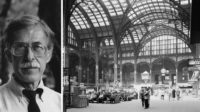Robert C. Lautman, Hon. AIA, died of pancreatic cancer in Washington, D.C., on October 20, 2009. He was fond of saying that his job was easy: all that an architectural photographer had to know was where to stand and what time to stand there. However, this throwaway remark about being in the right place at the right time glossed over a lifetime of intensive technical study and experimentation.
However, this throwaway remark about being in the right place at the right time glossed over a lifetime of intensive technical study and experimentation. Lautman was meticulous about choosing the right camera, lens, and film for a given situation, and equally careful in considering the way his negatives were developed and printed. His mastery of composition, light, and shadow made him the photographer of choice for Hugh Newell Jacobsen, FAIA, and developer James Rouse. His work was published in Architectural Record and other magazines and books countless times.Architectural photographer Robert C. Lautman, Hon. AIA, died of pancreatic cancer in Washington, D.C., on October 20, 2009. He was fond of saying that his job was easy: all that an architectural photographer had to know was where to stand and what time to stand there.
Lautman’s career had some unusual moments. He was a twice-decorated Army photographer in World War II, and shot combat photos at Corregidor. In 1954, he refused to answer questions while appearing before the House Committee on Un-American Activities.
But, he was not all business and his hospitality and sense of humor were legendary. Among the vocations listed on his business card was “Lunch” and he had a seemingly endless repertoire of jokes, some good and some bad. His life and work will be remembered in the Great Hall of the National Building Museum in Washington, D.C., at 6:30 p.m. on Friday, December 4.













Post a comment to this article
Report Abusive Comment